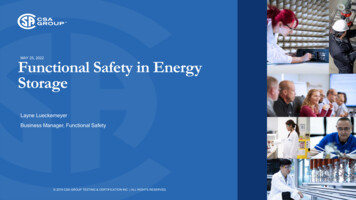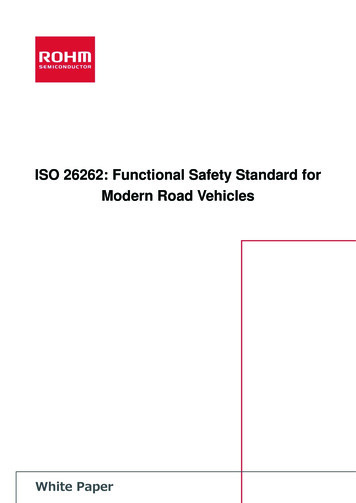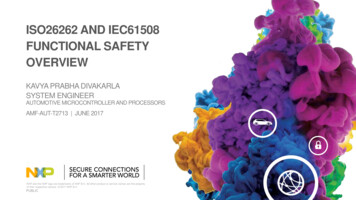
Transcription
MAY 25, 2022Functional Safety in EnergyStorageLayne LueckemeyerBusiness Manager, Functional Safety 2019 CSA GROUP TESTING & CERTIFICATION INC. ALL RIGHTS RESERVED.
About the SpeakersLayne Lueckemeyer, Global Functional Safety Business Manager for CSAGroup is a leading global compliance professional with more than twodecades of experience in consultative sales leadership, helping customersunderstand worldwide Functional Safety, EMC/EMI, Wireless,Environmental, Reliability, Product Safety, Machinery Safety, and HazardousLocations testing and certification requirements.Jody Leber, Global Energy Storage Business Manager for CSA Group isan International Compliance Professional with 30 years of experience inthe industry. His specialties include Battery, Electromagnetic Interference,Electromagnetic Compatibility, Environmental Simulation, Product Safety,and Renewable Energy.Insert Jody’s pictureCONFIDENTIAL2
Agenda Introduction Functional Safety – What, Why, and How?INSERT DIAGRAM / PICTURE Functional Safety Standards Functional Safety EvaluationCONFIDENTIAL3
IntroductionAs the Energy Storage market continues to grow,manufacturers struggle with the regulatory issues facing themevery day. These hurdles can be time-consuming andexpensive to overcome. Increased reliance on electronics andembedded software for safety monitoring and critical safetycontrols drive the need to consider Functional Safety inaddition to Electrical Safety requirements.INSERT DIAGRAM / PICTURECONFIDENTIAL4
Challenges for Manufacturers Safety Analysis can be complicated and time exhaustive Determining which standards are relevant for compliance Compliance with electrical safety requirements may not be enoughCONFIDENTIAL5
What is Functional Safety? Part of the overall safety concept that depends ona system or equipment operating correctly inresponse to inputs. Functional safety is achieved when all the specifiedsafety functions are carried out and the level ofperformance required of each safety function hasbeen met.INSERT DIAGRAM / PICTURE Functional safety is undertaken by activesystems. Safety achieved by passive elements is notconsidered functional safety.CONFIDENTIAL6
Hazard & Risk A hazard is anything that may cause harm “Something with the potential to cause harm” Physical injury or damage to health A risk is the chance, high or low, that somebody couldbe harmed by a hazard, plus an indication of howserious the harm could be.INSERT DIAGRAM / PICTURECONFIDENTIAL7
Why is Functional Safety Important?Example - Battery Management System (BMS)The BMS monitors Voltage Current TemperatureINSERT PICTURE – BatteriesWhat happens if the BMS fails? Thermal runaway Fire Potential for catastrophic consequencesCONFIDENTIAL8
UL 1973 Batteries for Use in Stationary and Motive Auxiliary Power ApplicationsSection 7.8 System Safety Analysis Hazard Identification Risk Analysis Risk EvaluationAnalysis Documents IEC 60812 IEC 61025 MIL-STD 1629A IEC 61508 OtherINSERT DIAGRAM / PICTURECONFIDENTIAL9
UL 1973 Batteries for Use in Stationary and Motive Auxiliary Power ApplicationsMinimum Requirements Cell Over-Voltage Cell Under-Voltage Battery Over-Temperature Battery Under-Temperature Battery Over-Current (Charge) Battery Over-Current (Discharge)INSERT DIAGRAM / PICTUREGeneral Requirements Reliability of Monitoring Components and Systems Communications that Affect Safety Single Fault ConditionsCONFIDENTIAL10
UL 1973 Batteries for Use in Stationary and Motive Auxiliary Power ApplicationsSection 7.9 Protective Circuit and ControlsActive protective devices may not be relied upon forcritical safety unless they comply with the following: IEC 61508 (SIL Level 2 or better) ISO 13849 (PL c) ISO 26262 (ASIL C)INSERT DIAGRAM / PICTURECONFIDENTIAL11
UL 9540 Energy Storage Systems and EquipmentSection 15 System Safety Analysis Hazard Identification Risk Analysis Risk Evaluation Consider Compatibility of System ComponentsINSERT DIAGRAM / PICTUREAnalysis Documents IEC 60812 IEC 61025 MIL-STD 882E OtherCONFIDENTIAL12
UL 9540 Energy Storage Systems and EquipmentActive protective devices may not be relied upon forcritical safety unless they comply with the following: IEC 61508 (SIL Level 2 or better) ISO 13849 (PL c) ISO 26262 (ASIL C)INSERT DIAGRAM / PICTURECONFIDENTIAL13
IEC 62619 Secondary cells and batteries containing alkaline or other non-acid electrolytes Safety requirements for secondary lithium cells and batteries, for use in industrialapplicationsSection 8 Battery system safety (considering functional safety) Hazard Analysis Risk Assessment Safety Integrity Level (SIL)INSERT DIAGRAM / PICTUREAnalysis Documents IEC 60812 IEC 61025 OtherCONFIDENTIAL14
IEC 62619 Secondary cells and batteries containing alkaline or other non-acid electrolytes Safety requirements for secondary lithium cells and batteries, for use in industrialapplicationsBattery management system (or battery management unit)Considers Key Factors Voltage Temperature CurrentINSERT DIAGRAM / PICTURETests Overcharge control of voltage (battery system) Overcharge control of current (battery system) Overheating control (battery system)CONFIDENTIAL15
IEC 62933-5-2 Electrical energy storage (EES) systems - Part 5-2: Safety requirements forgrid-integrated EES systems - Electrochemical-based systemsSection 6 BESS system risk assessmentSubsystems to consider Management (System Controller) Communication (Operation Panel) Protection (Relays) Auxiliary (Fire, Heat, Smoke Detectors) Auxiliary Connection (Terminals and Cable) Electrochemical Accumulation (Battery) Power Conversion (Inverter) Primary Connection (Terminals and Cable) Others (Building and Infrastructure)INSERT DIAGRAM / PICTURECONFIDENTIAL16
The Need for Functional Safety StandardsUL onicsand/orsoftwareare used onUL 9540 EnergyStorageUL 1741 InvertersIEC 62619 Cells &BatteriesIEC 62933-5-2Grid IntegratedEES SystemsUL 991UL 991UL 991IEC 60730IEC 61511UL 1998UL 1998UL 1998IEC 61508IEC 61508CSA C22.2No. 0.8CSA C22.2No. 0.8CSA C22.2No. 0.8IEC 60730IEC 60730IEC 60730IEC 61508IEC 61508IEC 61508ISO 13849ISO 13849ISO 13849ISO 26262CONFIDENTIAL17
Functional Safety Standards Principles Hazard and Risk Management – What risks are present in the system? Quality Management – Are there procedures for managing the lifecycle of theproduct? Measures to Address Random Failures – Does the architecture of thecontrol have redundancy? How reliable are the components? Measures to Address Systematic Failures – Are software procedures inplace to eliminate bugs? Can the product withstand EMI and Environmentalstresses?CONFIDENTIAL18
Systematic Faults vs. Random Faults Systematic Faults Design faults, human error Specification errors Software-related failures, bugs Faults due to environmental stress and EMC/EMI Random Faults Related to hardware, usage, and wear of components Occurrence is random in nature Average failure rates are usually known or predictableINSERT DIAGRAM / PICTURECONFIDENTIAL19
Comparison of Functional Safety StandardsSystematic vs. Random FaultsIEC 61508IEC/UL/CSA 60730-1 Annex HUL 991 / UL 1998Functional Safety RatingSafety Integrity Level (SIL)Control Class A, B, CSoftware Class 1, 2Systematic Integrity(Addressing SystematicFaults)Processes, methods, techniquesrequired depending on SILProcesses, methods, techniquesrequiredProcesses, methods, techniquesrequiredArchitectural Requirements(Addressing Random Faults)Hardware fault tolerance (HFT)Single or dual channel dependingon Control ClassSingle or dual channel dependingon Software ClassFault Detection Requirements(Addressing Random Faults)Measures and techniquesprovide diagnostic coverage(Safe Failure Fraction)Periodic self-test or functionaltest can be used depending onControl ClassPeriodic self-test or functionaltest can be used depending onSoftware ClassReliability (AddressingRandom Faults)SIL achieved by leveragingcomponent failure rates, HFT,and SFFQualitative analysis onlyComputational or DemonstratedmethodCONFIDENTIAL20
Failures Addressed by Functional Safety Failure rate of embedded systems over time Early failures typically addressed by systematic faults,or faults inherent to the system design Random faults of the hardware and microelectronics Functional Safety requirements are focused onavoiding/detecting both systematic and random faultsINSERT DIAGRAM / PICTURECONFIDENTIAL21
Safety AnalysisCONFIDENTIAL22
Safety AnalysisHazard and risk assessment conducted by the manufacturer to identify hazards and how they have beenmitigated by the design elements. Some common hazard and risk assessment techniques are: Failure Mode and Effects Analysis (FMEA) Fault Tree Analysis (FTA) Guidance for FMEA and FTA methods can be found in IEC 60812, IEC 61025, and MIL-STD 1629A Typical Process: Hazard analysisRisk assessmentSafety integrity level (SIL) or Performance Level (PL) target Examples of hazards that could be identified: EMC, overcharge, over-discharge, overcurrent, overvoltage,over-temperature, etc.CONFIDENTIAL23
Failure Mode and Effects Analysis (FMEA) “Bottom up” approach Each component and its failure modes are noted along with the corrective action used in the safetydesign. Software failure conditions are also listed. Note that the FMEA analysis reflects the system view and includes potential failures in any component,safety-related device, or software component.Failure Mode and Effects AnalysisSystemPotential FailureModePotential EffectRisk LevelControl MechanismBatteryOverdischargeThermal RunawayHighBMS VoltageSensingBatteryOverchargeThermal RunawayHighBMS VoltageSensingCONFIDENTIAL24
Fault Tree Analysis – (FTA) “Top-down” approach where the identified hazard is shown at the top, and where the bottom failureevents or “basic events” can no longer be subdivided. Technique for reliability and safety analysis that uses logic blocks in a diagram to show graphically therelationship between an identified hazard and each of the potential fault events that could result in thathazard.CONFIDENTIAL25
Battery Management System (BMS) ureOvercurrentShort DiagnosticsDiagnosticsBattery State ofHealth (SOH)TemperatureMonitoringCell BalancingSOCPower LimitsCONFIDENTIAL26
Battery Management System (BMS) ExampleSAFETY Safety Analysis identifies safetyfunctions reliant on the BMS Defines the scope of theFunctional Safety evaluationOvercharge: BMS shall transition battery to asafe state upon detection of a cell voltage 4.0VSafetyOverdischarge: BMS shall transition batteryto a safe state upon detection of a cellvoltage 2.5VOvertemperature: BMS shall transitionbattery to a safe state upon detection of atemperature 60 COvercurrent: BMS shall transition battery toa safe state upon detection of acharge/discharge current 12ACONFIDENTIAL27
Functional Safety EvaluationCONFIDENTIAL28
Functional Safety Documentation RequirementsInformation ItemDetailsProduct & Operational description System configurations that apply to the certificationDescription of all modes of operationSafety Analysis List of ‘identified’ hazard(s) to be included in the safety design.Result of Fault Tree analysisFailure modes for any safety-critical I/O operation (FMEA) Safety Requirements that apply to the product (combined hardware and software) as derived from the safety functions and from the hazardanalysis.Safety Requirements Functional block diagramAll major equipment components.Safety designFault reaction time(s)Schematic and wiring diagrams List of safety requirements that apply to the softwareDetails showing how the software design covers all software safety requirements and design requirements from the standardSystem Testing Test results covering each of the main test areasTest plan covering all software with test procedures and test casesSoftware Development Procedures Procedures for software developmentSoftware Tools List of software toolsSystem Architecture andSafety DesignSoftware Safety Requirement andSoftware DesignCONFIDENTIAL29
Hardware Assessment With respect to the safety functions identified in thehazard and risk assessment, the hardware isassessed to ensure it has a sufficient combination of: Redundancies Fail-safe techniques (built-in self-test, diagnostics, etc.) Reliable componentsINSERT DIAGRAM / PICTURE This ensures that the safety functions will work whenneeded most, and random hardware failures will notcause a risk of a hazard occurringCONFIDENTIAL30
Hardware Assessment Environmental Stress Tests Electronics undergo a series ofenvironmental stress tests Safety functions are verified for correctoperation before, during, and after each ofthe environmental stresses Only if the safety function still workscorrectly, or the product transitions to asafe state, are the test results consideredcompliantUL 991 Example Test PlanSection 616Failure-Mode and Effect AnalysisElectrical SupervisionOperational VerificationOvervoltage and Undervoltage TestsPower Supply Voltage Dips and Short Interruption TestTransient Overvoltage TestVoltage Variation TestElectrical Fast Transient/Burst Test181920212224262728Thermal Cycling TestHumidity TestDust TestVibration TestJarring TestComputational InvestigationPower Cycling Tests – GeneralOverload TestEndurance TestRadiated EMI TestKeying Interference TestElectrostatic Discharge TestElectric Field TestMagnetic Field TestComposite Operational and Thermal Cycling TestCONFIDENTIAL31
Software RiskAnalysisSoftware Assessment Reduce/eliminate software bugsand defectsDesign Documented formal processes Risk Analysis Defining and documentingrequirements Planning software architecture ImplementationSoftwareDevelopmentLife CycleEvolution Analyzing, debugging, and testingImplementation Software release,changes/maintenance to softwareTestingCONFIDENTIAL32
Product confidenceFunctional Safety ensures: Hazards and risks of the product areidentified and mitigated Hardware is reliable Electronics are not susceptible to adverseenvironmental conditions Software is free of bugs and defectsFunctional Safety ensures the productwill operate safelyCONFIDENTIAL33
Summary Functional Safety – What, Why, and How? When is a Functional Safety evaluationrequired? Safety Analysis Hardware Assessment Software Assessment Remote Software UpdatesCONFIDENTIAL34
Questions?
Thank you.Layne LueckemeyerBusiness Manager, Functional Safety 1 251 504 8098Layne.Lueckemeyer@csagroup.orgJody LeberBusiness Manager, Energy Storage 1 xxxxxxJody.Leber@csagroup.org
IEC 61508 IEC/UL/CSA 60730-1 Annex H. UL 991 / UL 1998. Functional Safety Rating; Safety Integrity Level (SIL) Control Class A, B, C: Software Class 1, 2. Systematic Integrity (Addressing Systematic Faults) Processes, methods, techniques required depending on SIL. Processes, methods, techniques











